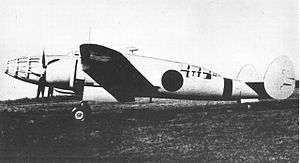Tachikawa Ki-70
| Ki-70 | |
|---|---|
 | |
| Role | Reconnaissance |
| National origin | Japan |
| Manufacturer | Tachikawa |
| First flight | 1943 |
| Status | Prototype |
| Number built | 3 |
|
| |
The Tachikawa Ki-70 "Clara" was a high speed photo reconnaissance aircraft that was tested for the Japanese Air Force in prototype form but never entered production. The Ki-70 was the intended successor to the Mitsubishi Ki-46 but was difficult to handle and was slower than the Mitsubishi Ki-46. The Ki-70 was first flown in 1943 but was found unfavorable and the program was terminated. Three were built.
History
In later years the Ki-70 was used to disprove supposed photographic evidence concerning Amelia Earhart's supposed capture by the Japanese before World War II.
Description
Using the familiar layout of aircraft such as the Mitsubishi G3M bomber and its planned predecessor the Mitsubishi Ki-46, the Ki-70 had a twin tailed with a narrow fuselage. The aircraft had an extensively glazed nose and second cockpit facing aft for the gunner.
Specifications (Ha-104M engine)
(Performance estimated except where indicated)
Data from Japanese Aircraft of the Pacific War [1]
General characteristics
- Crew: 3
- Length: 14.50 m (47 ft 6⅞ in)
- Wingspan: 17.80 m (58 ft 4¾ in)
- Height: 3.46 m (11 ft 4¼ in)
- Wing area: 43.0 m² (463 sq ft)
- Empty weight: 5,895 kg (12,996 lb)
- Loaded weight: 9,855 kg (21,727 lb)
- Max. takeoff weight: 10,700 kg (23,589 lb)
- Powerplant: 2 × Mitsubishi Ha-104M 18-cylinder air-cooled radial engine, 2,070 hp (1,544 kW) at 1,000 m (3,300 ft) each
Performance
- Maximum speed: 580 km/h[2] (313 knots, 360 mph) (trials performance)
- Cruise speed: 490 km/h (263 knots, 304 mph) at 5,400 m (17,700 ft)
- Range: 2480 km (1,340 nmi, 1,541 mi)
- Service ceiling: 11,000 m (36,100 ft)
- Climb to 5,000 m (16,400 ft): 5 min
Armament
- Guns: 1x 12.7mm MG, 1x 7.7mm MG
See also
- Aircraft of comparable role, configuration and era
References
Notes
Bibliography
- Francillon, Réne J. Japanese Aircraft of the Pacific War. London: Putnam, 1970. ISBN 0-370-00033-1.
- Francillon, René J. Japanese Aircraft of the Pacific War. London: Putnam Aeronautical, 1979. ISBN 0-370-30251-6. (new edition 1987. ISBN 0-85177-801-1.)
External links
| Wikimedia Commons has media related to Tachikawa aircraft. |